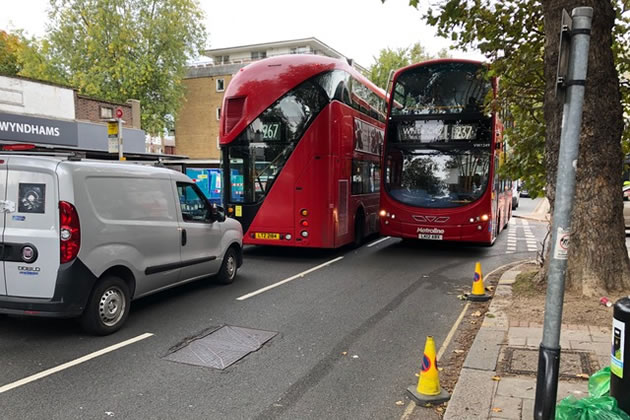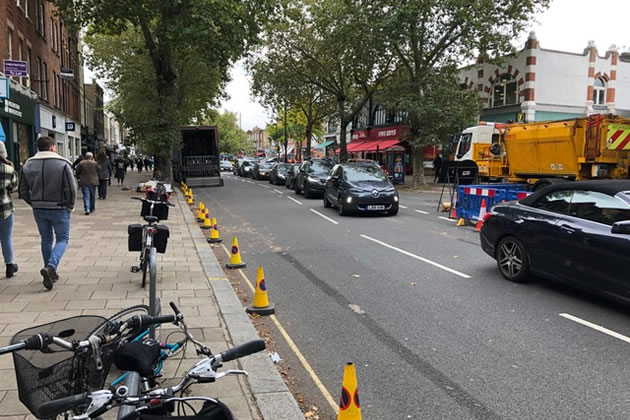Local Cycling Campaigner Says Temporary Cycleway a 'Death Trap'
Stephen Donnelly claims safety standards have been compromised

Cycle lane has led to a narrowing of Chiswick High Road
A local architect and cycling campaigner has described the temporary Cycleway 9 currently being implemented on Chiswick High Road as a death trap.
Stephen Donnelly said, “Cyclists’ concerns about the dangers posed by the temporary Cycleway 9 on Chiswick High Road are being ignored by Hounslow Council and Transport for London. Work on the scheme —criticised as rushed and cut-price — is already underway but the lowering of safety standards and lack of adequate risk assessment or safety audit has sounded alarms.”
Mr Donnelly, who lives in Chiswick, has urged that Hounslow Council insist that TfL stop work on the scheme immediately and redesign in accordance with what he says would be good practice.
He adds that, while he supports the need to provide a better alternative to cars and public transport during the pandemic, he does not believe that this can justify the lowering of safety standards
He produced a report at the time of the submission of the original permanent design for the scheme and his concerns have increased due to changes that have taken place in the temporary cycleway. He claims there is a lack of adequate protection for cyclists at side road junctions to prevent collisions with motor traffic. Unlike the original scheme there are no raised humps across the junctions to slow crossing traffic or the recommended five-metre long space for cars waiting to cross the track.
He also asserts that the introduction of a two-way cycle track with priority over side road junctions is wholly untested in the UK and that safety standards recommend they should be avoided on urban streets with multiple side road junctions, and if introduced, junctions must be very carefully designed to avoid the high risk they present to cyclists travelling against the adjacent traffic flow.

Bi-directional cycleway being implemented in Chiswick
He also says that expert advice from CROW the technology platform for transport, infrastructure and public space in the Netherlands states that two-way tracks are always more dangerous than one-way tracks on busy urban streets with head-on collisions between cyclist more likely. Also cyclists having to cross the street to get to the cycleway are at risk of collision and pedestrians often forget to look both ways when crossing a bi-directional track.
He points to the lack of experience, even internationally of using "traffic wands" to separate cyclists from oncoming motor traffic, which have the potential to provide inadequate separation.
Mr Donnelly says that only a well-designed scheme of one-way cycle tracks on either side of Chiswick High Road could provide adequate safeguards to protect cyclists, pedestrians and motorists alike. Hounslow Council has said previously that cycleways running in the same direction as traffic were not possible because of the width of the High Road.
He has raised these issues with Hounslow Council but says its response was inadequate since it does not take account of the experimental nature of the design; the failure to adhere to internationally recognised design standards for junctions with side roads and the inherent safety issues of bi-directional cycle paths in a busy urban setting.
We asked Hounslow Council for comments on Mr Donnelly’s report and await a response.
Find Articles Like This Useful? Help Us Produce More This site remains committed to providing local community news and public interest journalism. Articles such as the one above are integral to what we do. We aim to feature as much as possible on local societies, charities based in the area, fundraising efforts by residents, community-based initiatives and even helping people find missing pets. We’ve always done that and won’t be changing, in fact we’d like to do more. However, the readership that these stories generates is often below that needed to cover the cost of producing them. Our financial resources are limited and the local media environment is intensely competitive so there is a constraint on what we can do. We are therefore asking our readers to consider offering financial support to these efforts. Any money given will help support community and public interest news and the expansion of our coverage in this area. A suggested monthly payment is £8 but we would be grateful for any amount for instance if you think this site offers the equivalent value of a subscription to a daily printed newspaper you may wish to consider £20 per month. If neither of these amounts is suitable for you then contact info@neighbournet.com and we can set up an alternative. All payments are made through a secure web site. One-off donations are also appreciated. Choose The Amount You Wish To Contribute. If you do support us in this way we’d be interested to hear what kind of articles you would like to see more of on the site – send your suggestions to the editor. For businesses we offer the chance to be a corporate sponsor of community content on the site. For £30 plus VAT per month you will be the designated sponsor of at least one article a month with your logo appearing if supplied. If there is a specific community group or initiative you’d like to support we can make sure your sponsorship is featured on related content for a one off payment of £50 plus VAT. All payments are made through a secure web site. |
October 18, 2020